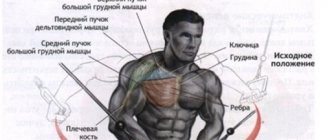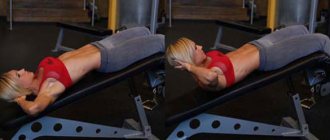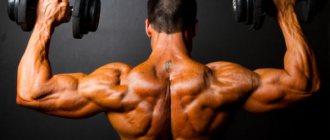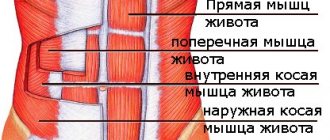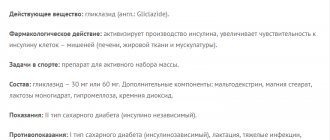Human body - This is a universal mechanism that under no circumstances will increase engine volume unless absolutely necessary. We guessed what we were talking about.
Remember, in order to pump up any muscle group and gain total body weight, you need to create conditions under which the body simply needs to hypertrophy your muscles. Every kilogram of muscle mass for our body is an additional waste of energy, which is why it is so difficult to build and maintain muscle.
How to work correctly with the muscles of the sternum with a barbell, dumbbells, and parallel bars
When starting chest development exercises, it is important to understand how to properly load the muscles to get maximum benefit. There are a few tips to follow:
- First of all, perform exercises with a barbell, for example, a bench press or with dumbbells (dumbbell press);
- As auxiliary movements, you can use fly-outs or isolated exercises on simulators;
- to increase volume you need to do 2-4 exercises of 6-15 repetitions. You should not focus on high-repetition movements;
- to develop the chest, a wide and medium grip is used; with a narrow grip, the triceps are more involved in the work;
- parallel bars can be used as a main and auxiliary exercise.
The technique used to perform the exercises will depend on the type of movement. So, for example, the bench press is performed as follows:
- the athlete lies down on the bench so that his eyes are opposite the bar;
- grab the barbell with your hands, wide or medium, evenly from each edge;
- the rod rises from the racks independently or with the help of a belayer;
- first movement - the barbell lowers to the chest while inhaling;
- after a short pause, the projectile rises upward, with a sharp movement with maximum effort, while exhaling;
- the movement is repeated the required number of times.
The dumbbell press is performed in the same way, the only difference is that the dumbbells are either held straight, or their trajectory changes when moving up and down (at the top point they stand “in a row”, and at the bottom they are parallel to each other).
When doing dips, you can either use additional weight or do without it, it all depends on your level of training. The technique is approximately as follows:
- the athlete stands near the bars and climbs on them with outstretched arms;
- first movement - the body lowers as low as possible while inhaling;
- second movement - the body rises as you exhale.
Important! During exercises on the uneven bars, your arms should be kept straight, without allowing vibrations in the area of the elbows. With a wide stance, the load falls more on the pecs, and with a narrow stance, it shifts to the triceps.
At the beginning, it is quite difficult to understand how to do it correctly with a barbell, how to do it correctly with dumbbells and on parallel bars, so it is better to use minimal weights until you fully master the technique. This will ensure minimal risk of injury.
Be sure to watch: “Making” breasts without surgery and diets: exercises for the sternum muscles for women and girls Recommendations on how to pump up a girl’s chest and quickly tidy up a man’s sternum muscles at home Features of chest-back training in one day: an exercise program for beginners and advanced athletes Exercises that will help pump up the sternum muscles for a man
Pectoral muscle training for mass
If you have recently started bodybuilding (less than a year), then it is best to use basic exercises, since thanks to them you will progress faster and gain muscle mass in your chest. And when your pecs are more or less developed, then you can add isolated exercises (no more than two).
What grip should you use when training your pectoral muscles?
For safety, it is best to use a “closed” grip, where the thumb wraps around the bar (under the letter B in the picture). This way you will insure yourself against the fact that the barbell may simply slip out of your hands (your palms will sweat and the barbell will “move”). In addition, do not grab the bar with too wide a grip, as this will create additional stress on the shoulder joints, which is not good. The best option is a grip slightly wider than shoulder width. When you lie down under the bar, make sure the bar is at eye level. This is the correct position.
Correct technique
If you are doing pressing movements, make sure that your elbows do not diverge to the sides and are not pressed to the body. The correct position of the elbows is approximately 45 degrees relative to the body. At the bottom, your forearms should be perpendicular to the floor.
If you do flyes, make sure that your arms are slightly bent at the elbow joint throughout the exercise.
Do not lift your lower back off the bench and rest your feet on the floor.
Insurance
In all pressing exercises, it is better to use the help of a partner or ask someone from the gym to back you up. This way you can better concentrate on the exercise and not think that if you can’t squeeze the barbell again now, it will crush you.
Also, be sure to put locks on the barbell so that if the barbell becomes skewed, all the weights won’t fall off.
What exercises for home and gym should be included in the program for pumping up the pectoral muscles?
Pumping the chest muscles and working on mass is carried out through a series of exercises. The most popular basic movements when training in the gym are:
- bench press on a horizontal bench;
- incline bench press;
- dumbbell press on a horizontal and inclined bench;
- raising dumbbells on a horizontal and inclined bench;
- presses in simulators;
- dips;
- crossover.
This is the main backbone on which the training program is built.
Breast development at home is done using push-ups. They should be the main exercise. Such exercises are performed according to various schemes, different positions of the arms and legs are combined, and additional weight is used (for example, in a backpack).
You may also be interested in: Chest exercises at home
How many times a week should you exercise
When creating a training program, you need to determine how quickly the muscles recover after performing exercises. These processes are individual in nature, some need a week to recover, others need several days. Without going into details of the stages of the process, we can conclude that it is necessary to perform movements on the pectoral muscles once or twice a week.
At the beginning of training, it is best to base yourself on your own feelings. The muscles will ache, this is a normal reaction to training. In case of acute pain, it is not worth repeating the load on the muscle group; it is better to let the body complete the processes.
Program for pumping the muscles of the sternum
Training should be based on a scheme, that is, a training program. The plan is drawn up at the beginning of classes and adjusted based on your own feelings, progress, recovery speed and other factors.
The plan will be different for beginners and more experienced athletes. At first, it is recommended to perform fewer exercises, giving preference to basic, multi-joint movements. Then the isolated ones are included, and other diversity is introduced.
For newbies
When we pump our chest, other muscles come into play. This factor must be taken into account when creating a training program. For beginners, it is better to train according to the principle of a three-day split, focusing each workout on two or three muscles.
A sample plan looks like this:
| Workout 1 | Legs and shoulders. 2-3 leg exercises (for example, squats, lunges and machine leg presses), then 2 shoulder exercises (standing barbell press and seated dumbbell press) for 3-4 sets of 6-12 reps. |
| Workout 2 | Chest and triceps. Bench press 4 sets of 8-15 reps. Incline dumbbell press, 3 sets of 8-15 reps. Dumbbell flyes, 3 sets of 10-12 reps. Triceps on the block, 4 sets of 10-15 reps. Dips, 4 sets of 10-12 reps. |
| Workout 3 | Back and biceps. Option: deadlift, barbell row, pull-up, biceps curl, dumbbell curl on a Scott bench. 3-4 sets of 6-12 repetitions. |
Training can be alternated differently. For example, the pecs can be combined with the back, shoulders, and so on. The main thing is that the body has time to recover. Before pumping the lower chest separately (or the upper), it is worth paying attention to the overall development, then the weaknesses will become clear, and the program will change depending on them.
For advanced
More experienced athletes can pay more attention not to general training, but to individual parts of the pectoral, isolating movements. But before training the lower part of the sternum muscles or, conversely, the upper part, it is worth performing basic exercises, only then moving on to special movements.
A chest/triceps training day might look like this:
- bench press, 4 sets of 10-12 reps;
- dumbbell press, 3 sets of 10-15 reps;
- Incline bench press, 3 sets of 12-15 reps;
- crossover, 3 sets of 12-15 reps;
- French press, 4 sets of 12 reps;
- bent over triceps extension, 3 sets of 10-12 reps.
Another training option for combining the load on the chest and shoulders is as follows:
- bench press with a barbell, 4 x 10;
- Smith machine press, 3 x 10;
- crossover, 3 to 12;
- dumbbell flyes, 3 to 12;
- standing barbell press, 4 x 12;
- Arnold press, 4 to 12-15.
There are quite a lot of options. For example, a five-day split can be used, when training is carried out 5 times a week, then a separate day is devoted to the chest, approximately 5-6 movements are performed.
You may also be interested in: How many times a week should you exercise?
Exercises
Now let's talk about exercise. In any chest exercise, the ability to contract “what you need” with the help of your brain is very important. Those. the neuromuscular connection that we talked about. The better this connection, the stronger the muscle contraction, the better the growth. And in order to facilitate the “convenience” of such a connection, such a thing as the correct technique for performing exercises was invented. This is what makes it easier to contract the muscles you need.
So, a lot of exercises are used to train the pectorals, but since the pectoral muscles are a pushing group, they can all be divided into two categories:
Presses (barbells, dumbbells, in the simulator) Flyes (dumbbells, crossovers, hammers, etc.)
In the first case, two joints are involved (shoulder and elbow), so these are basic exercises. In the second case, the elbow joint is fixed and only the shoulder joint works, so this is a single-joint or isolating exercise. Let's start with basic chest exercises. From bench presses. Because they are the ones who increase strength and mass.
TYPES OF PRESSES (by subject)
- Barbell
- Dumbbells
- Presses in simulators
TYPES OF PRESSES (by angle)
- Upside down
- Upside down
- Horizontal
PRESS (depending on grip width)
- Narrow grip
- Average
- Wide
The higher the head tilt, the more the upper chest works, the less the lower chest works. In addition, the higher the head tilt, the more the deltoids are involved and the more the triceps are turned off. This is important to consider when choosing the angle for the bench press.
The lower the head tilt in the presses, the more the lower pecs work on one side. And the more the triceps are included in the work and the deltoids are turned off, on the other hand. This is the second point to consider when performing bench presses.
The narrower the grip, the greater the amplitude of the exercise and the more work (it is more difficult to press) on one side. The narrower the grip, the more the triceps work, on the other hand. This is the third point to consider.
But enough theory. I don't want to overload your brain with a large amount of information. Let's start with a specific exercise.
How to quickly develop muscles: pro tips
The development of chest muscles requires a special approach. Progress can be achieved both at home and in the gym, but, according to professionals, a program for pumping up these muscles should preferably contain exercises with a barbell and dumbbells.
Professionals, especially coaches and experienced athletes, advise starting movements with heavy exercises that affect the chest as a whole and do not focus on any part. This is a barbell press, dumbbells, parallel bars, and in home exercises - push-ups. For women, it is better to do incline presses to develop the upper chest, which will allow it to “tighten” it somewhat.
Important! According to the pros, it is better to complete classes with isolating movements, which will help consolidate the result. Also, do not forget about the restoration of the body, which is carried out through proper nutrition and adherence to the regime.
Alexander Kodzoev, bodybuilder
A well-known bodybuilder in Russia uses a five-day split program, devoting a separate day to the chest. Depending on the season, either heavy multi-joint exercises or isolation exercises can be performed on this muscle group.
He advises non-professionals to focus on presses, as they will allow you to work the chest as a whole and only then move on to isolated movements. It is also worth correctly distributing the load, training the body as a whole, comprehensively and harmoniously, and not focusing only on chest training.
Dmitry Yashankin, bodybuilder
Dmitry Yashankin is known not only for his professional career, but also as the author of many training videos and techniques. He advises approaching body training consistently, taking into account the characteristics of the body, strengths and weaknesses. But in any case, you need to train the entire body.
In his opinion, it is better to train the chest with bench presses, then move on to movements on machines and other auxiliary exercises. For beginners, it is better to perform 2-3 exercises and allow the body to recover well, only strengthening the program over time.
Ekaterina Usmanova, fitness bikini
The athlete not only competed in fitness bikini, but also successfully participated in bench press competitions. She believes that even girls should do bench presses, as it will help harmoniously develop muscles and tighten their chest. Particular attention should be paid to the bench press of barbells and dumbbells on an incline bench, but also include fly-outs and movements on machines in the program.
Main conclusions
You need to train your chest consistently and in a variety of ways. It is necessary to provide the body with a load adequate to the level of training, and it should increase over time, gradually. It is best to choose basic, heavy movements, especially at the beginning of training.
The best exercises for chest development are considered to be the bench press, both barbells and dumbbells, as well as flyes, dips and a whole range of exercises on machines. Don’t forget about training the muscles that are auxiliary for chest movements, such as the back, triceps, abs and shoulders.
Video Denis Borisov - “Bedtime Prayer” (neuromuscular connection training)
Example: you do a lying down fly without weight (hands clenched into fists, but empty), slowly moving your hands, trying different vectors, listening to muscle contractions, artificially delaying similar contractions at the top point. In the future, you can take light dumbbells (2-4 kg) and do the same. Over time, your muscles will turn into helpful servants and will contract the way you need. For example, I can grab a barbell with a medium grip on the bench press and do a chest or triceps workout. Moreover, outwardly the difference will be almost not noticeable. BUT... in one case I will order the triceps to lift the weight, and in the other the pectoral muscles. In general, pray, friends. Pray...
The second important point is the lack of load progression. People, I’ve already set my teeth on edge from constant repetitions that the meaning of any athletic sport is a progression of loads. If the weights on your barbell do not change, then your muscles have no need to change their appearance and become stronger and bigger. This is the most important principle of sport. You can forget about everything else, but if you become a little stronger month after month (even by 1 kg in the bench press), then in a few years this will add fifty dollars to your barbell. And if you bench press 150-200 kg, then no matter how clumsy your lifestyle and training split are, your shoulder girdle will look very impressive.
The load can be progressed in various ways: increase the weight on the apparatus, reduce rest between approaches, increase the number of repetitions or the number of working approaches. BUT, for you, until you reach a bench press of 140-150 kg for 6 times, you can forget about everything else except increasing the weight on the bar. This is the main point of your struggle from training to training.
We recommend Underground 123. Don’t be like everyone else (brain clearing)
Setting a goal of 150 or 200 kg means “scaring” your conscious mind too much, which will begin to interfere with you, whispering “Dude, you won’t succeed... this is too much...”, so set conditionally achievable goals. For example, if you bench press 80 kg 8 times, then set yourself a goal to increase this result to 90 kg 8 times in 3-5 months. After this, it will be the turn of another goal - 100 kg. The more achievable the goal is nearby, the less “harmful whisperings” of our conscious mind.
The third most important point of lag is incorrect emphasis in the development of parts of the pectoral muscles . If your goal is chest size (hypertrophy), then you should start with those areas that always lag behind, and not with those areas that will allow you to bench press more weight. What are we talking about? ABOUT THE TOP OF THE CHEST AND THE INNER PARTS OF THE CHEST. It is these sections that give a holistic, voluminous appearance to your pectoral muscles, and it is these sections that develop very poorly due to anatomical reasons.
70% of the workout should target the top of the pectoral muscles, and 30% the bottom.
In modern schemes, everything happens exactly the opposite. The main exercise recommended is the barbell bench press on a horizontal bench and a number of other exercises (dumbbell presses, flyes), also performed on a horizontal bench.
As a result, a person receives an overdeveloped lower chest, with a dystrophic absence of the upper chest. If such a person quits classes, then the bottom may “sag” even more, completely ruining the entire aesthetics of the physique. Therefore, always focus on developing the upper pectoral muscles. You can completely forget about the bottom, or do a minimum of approaches for it. After all, the bottom of the pectorals itself grows very easily due to anatomy.
Our ancestors walked on all fours for a long time, and with this method of movement, the support vector is shifted to the bottom of the pectorals. That is why these parts are genetically very strong and are accustomed to “stealing” the load in any exercise. So there’s no point in giving it to them, period. Load the upper sections and then your chest will be developed much more evenly and better.

